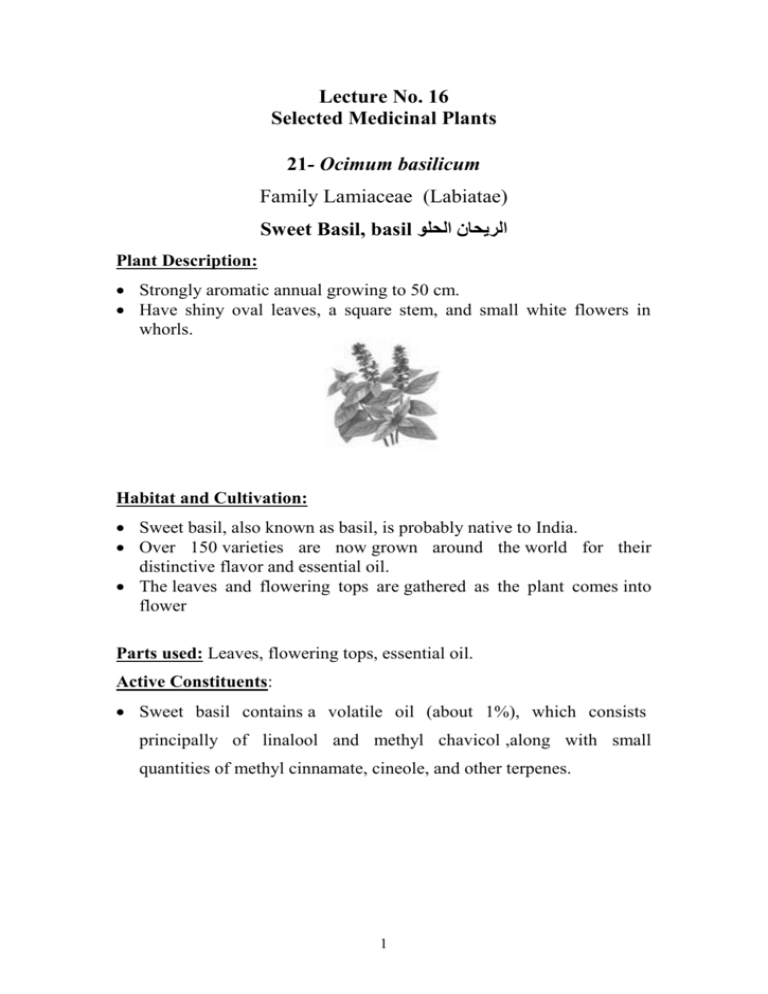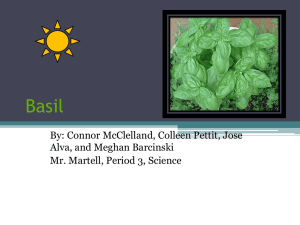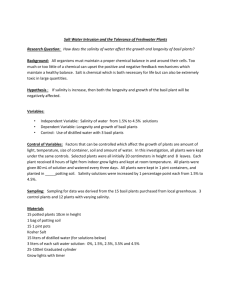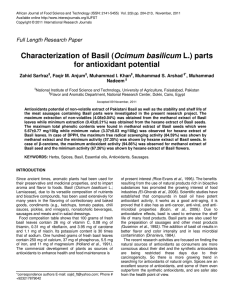Lecture No
advertisement

Lecture No. 16 Selected Medicinal Plants 21- Ocimum basilicum Family Lamiaceae (Labiatae) Sweet Basil, basil الريحان الحلو Plant Description: Strongly aromatic annual growing to 50 cm. Have shiny oval leaves, a square stem, and small white flowers in whorls. Habitat and Cultivation: Sweet basil, also known as basil, is probably native to India. Over 150 varieties are now grown around the world for their distinctive flavor and essential oil. The leaves and flowering tops are gathered as the plant comes into flower Parts used: Leaves, flowering tops, essential oil. Active Constituents: Sweet basil contains a volatile oil (about 1%), which consists principally of linalool and methyl chavicol ,along with small quantities of methyl cinnamate, cineole, and other terpenes. 1 History and Folklore In his 1st century AD Materia Medica, the Greek physician Dioscorides described the African belief that eating sweet basil checks the pain of a scorpion's sting. Ancient Romans used the herb to relieve gas, to counteract poisoning, as a diuretic, and to stimulate breast-milk production. Medicinal Action & Uses: Sweet basil acts principally on the digestive and nervous systems, easing flatulence, stomach cramps ,colic, and indigestion. It can be used to prevent or relieve nausea ( )الغثيانand vomiting ,and helps to kill intestinal worms. Sweet basil has a mildly sedative action, proving useful in treating nervous irritability, fatigue, depression, anxiety ( )القلققق, and insomnia ()ارق. It may also be taken for epilepsy ( )الصقع, migraine, and whooping cough. The herb has been traditionally taken to increase breast-milk production. Applied externally, basil leaves act as an insect repellent. The juice from the leaves brings relief to insect bites. Sweet basil has an established antibacterial action. Cautions The essential oil should not be taken internally. 2 22- Olea europaea Family Oleaceae Olive الزيتون Plant Description: -Evergreen tree growing to 10 m. has deeply grooved gray trunk. - Leaves are small and leathery. - Flowers occur in clusters, with greenish white color. - Fruits are green ripening to black. Habitat and Cultivation: -Olive trees grow wild in Mediterranean region and are cultivated in Mediterranean countries and in regions with similar climate in the Americas. - The leaves may be gathered as required through out the year, the fruit in late summer. - The leaves of wild trees are believed to contain a higher concentration of active principles. History and Folklore: - The olive was probably first cultivated in Crete in about 3500 BC. 3 - The tree has many symbolic associations: The branch is a symbol of peace, and the leaves were worn in a crown by victors in the ancient Olympic games. - The leaves are used since that time to clean wounds. - The oil has been used for ritual anointing in some religions. Parts Used: Leaves, oil. Active Constituents: Olive leaves contain - oleoropine. -oleasterol -leine -oleic acid (75%): mono unsaturated fatty acid. Medicinal Actions and Uses: - Olive leaves lower blood pressure. - help to improve the function of the circulatory system. - They are mildly diuretic. - May be used to treat conditions as cystitis. -Having some ability to lower blood sugar levels, so leaves have been taken for diabetes. - The oil is nourishing - It improves the balance of fats within the blood. - It is traditionally taken with lemon juice in teaspoonful doses to treat gallstones - The oil has a protective action on the digestive tract. - It is useful for dry skin. Research: Clinical trails have shown that olive leaves lower blood pressure. Remedy using olive oil. 4 For stretch marks in skin: massage olive oil firmly into the affected area of skin, 1-2 times a day. Traditional Remedy: -Used to treat coughing, diabetes, high blood pressure and stones in kidneys (fruit oil or leaf decoction are taken orally) -To treat muscle contraction, oil is rubbed on the affecting areas for muscle contraction 23- Origanum syriacum Syn Majorana syriaca Family Labiatae(Lamiaceae) الزعتر Introduction: * is native to the Mediterranean and is found in Syria, Palestine, Lebanon and Jordan. *Origanum syriacum is a medicinal plant widely used in Jordan and neighboring countries both as a folk remedy and in the food and beverage industry. *It represents the fastest, easiest, and most common and popular breakfast of the Jordanian people. * Once the plants are harvested after the flowering stage, they are dried and crushed to get a fine product composed mainly from the leaves and flowers. The taste of the raw Zaatar is very strong; hence some other ingredients such as Summaq (made from the fruits of Rhus coriaria), sesame seeds and salt are added to mellow the taste. * Origanum syriacum is also known as a medicinal plant for its ability to relief stomach and intestinal pain Plant Description: -It is 30-40 cm high, slightly hairy perennial with its oblong-ovate, 10-15 cm long leaves and with a nice "Thymus - like" smell. The flowers are white. - The strains of wild thyme or za`tar in the Middle East (Origanum syriacum L. and Thymus vulgaris L.) are different from those traditionally cultivated in Europe and the Americas 5 -Recently and due to its importance in the economic use of the country, Origanum syriacum has become a cultivated crop to cover the need of the local market. Active Constituents: It contains: Thymol, sabinene hydrate, terpinene, cymene and terpinen. Medicinal Use: -Origanums have been used to treat many conditions, from digestive problems, menstrual irregularities and cancer to aches, pains and the common cold and loss of memory. Also it is reported as antifungal. 24-Origanum vulgare Family Lamiaceae (labiatae) مردقوشOregano Plant Description: -Upright perennial herb growing to about 80 cm -Has square red stems, elliptical leaves and clusters of deep pink flowers. Habitat & cultivation: -Oregano is native to Europe and naturalized in the Middle East. - It is gathered when in flower in summer. Part Used: Aerial parts, essential oil Active Constituents: -Oregano contains: - Volatile oil (carvacrol, thymol (antibacterial and antifungal), beta bisabolene, linalool and borneol) 6 -Tannins - Resin - Sterols -Flavonoids History & Folklore: -Oregano was considered a cure –all in medieval times. -It was one of the medicinal plants cultivated by early New England settlers Medicinal Action & Uses: -Oregano helps to settle flatulence and stimulates the flow of bile. - Strongly antiseptic. -Treat respiratory conditions such as cough, tonsillitis, bronchitis and asthma. - Useful promoter of menstruation. - The diluted oil can be applied to toothache or painful joints. Cautions: -Do not take as a medicine during pregnancy. -External use may cause irritation of the skin. - Do not take essential oil internally. 7









![Summer CSA Week 1 Newsletter[2]](http://s3.studylib.net/store/data/008361034_1-929397ca27c7d29444e8afb352b8afc2-300x300.png)

